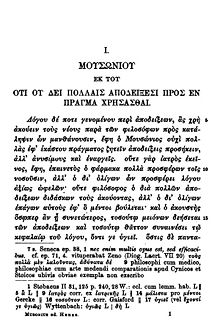This article needs additional citations for verification. (November 2022) |


A critical apparatus (Latin: apparatus criticus) in textual criticism of primary source material, is an organized system of notations to represent, in a single text, the complex history of that text in a concise form useful to diligent readers and scholars. The apparatus typically includes footnotes, standardized abbreviations for the source manuscripts, and symbols for denoting recurring problems (one symbol for each type of scribal error).
As conceived of by one 19th-century editor:
The object of a critical apparatus .. is to enable the earnest student to form his own text. It is therefore an editor's duty to give all the material variants of all the independent manuscripts. It is particularly his duty in a case like the present where there are many passages of which he can give no satisfactory explanation.[1]
- ^ Ashburner, Walter, ed. (1909). Rhodian Sea-Law. Oxford: Clarendon Press. p. iii.